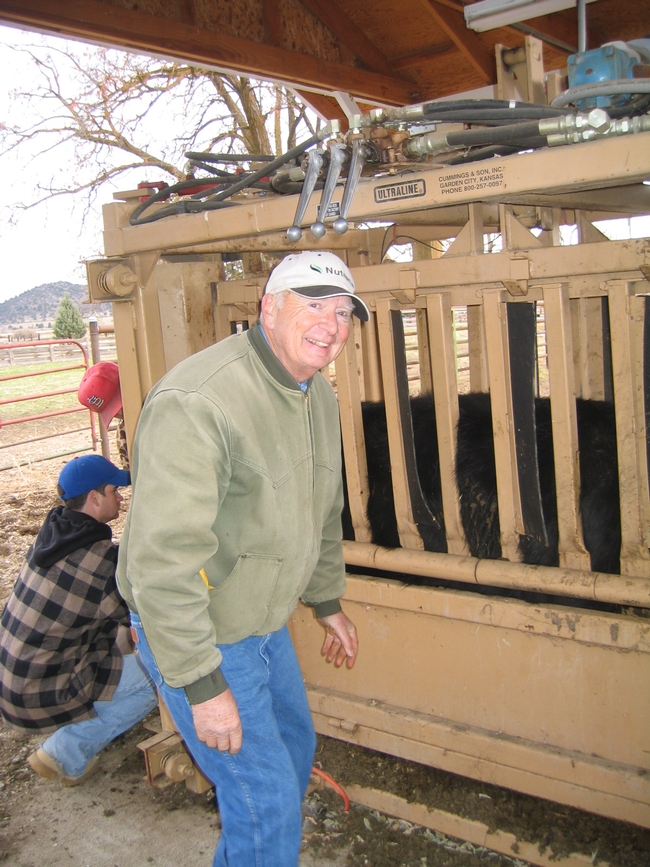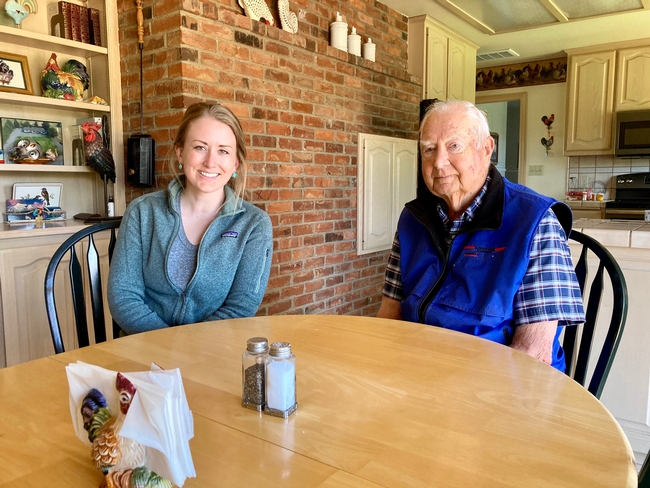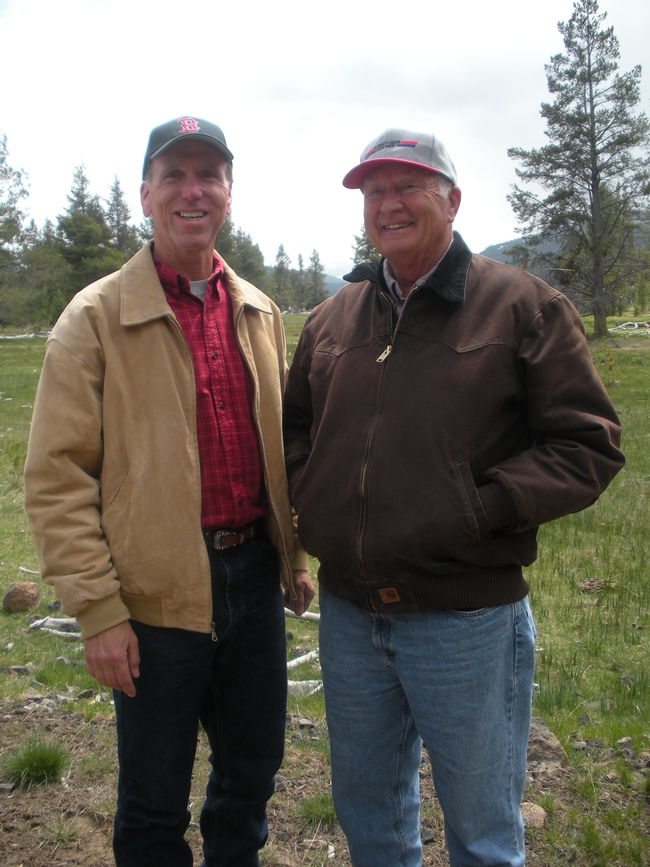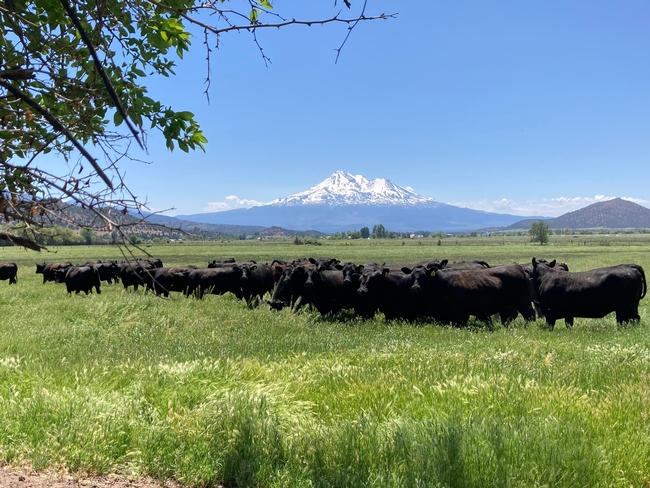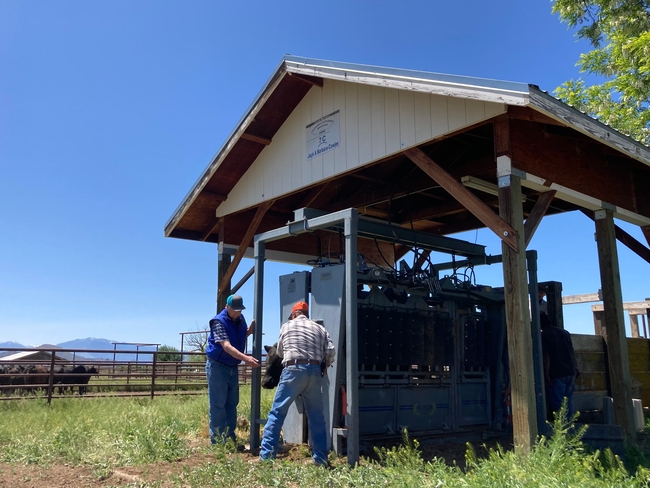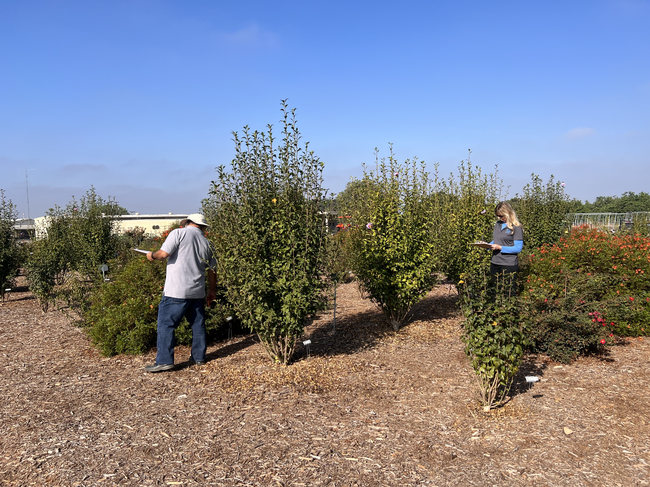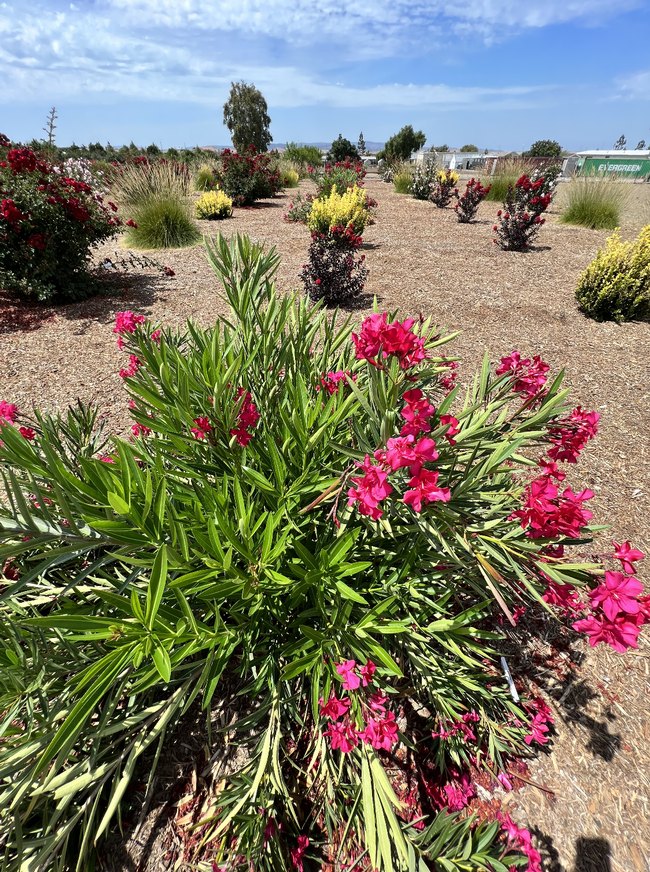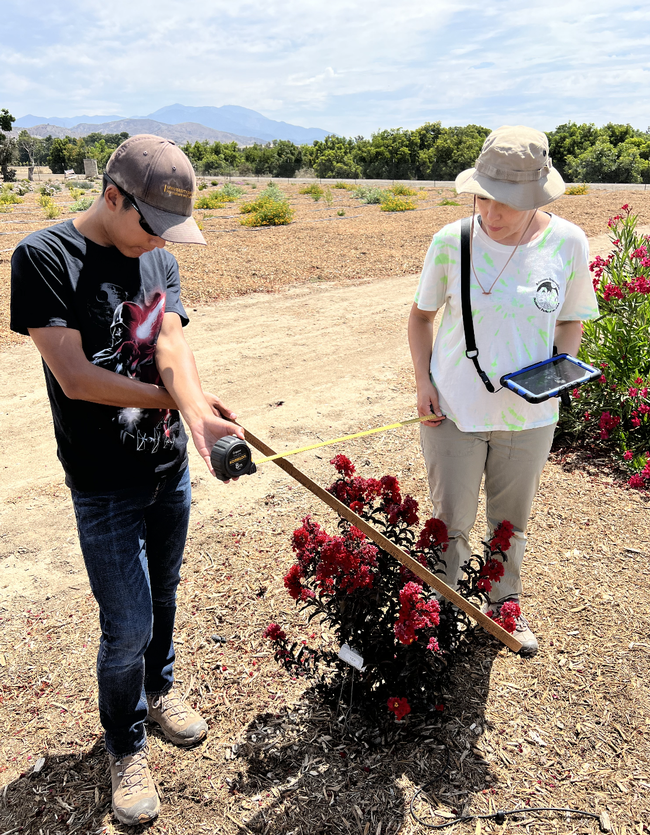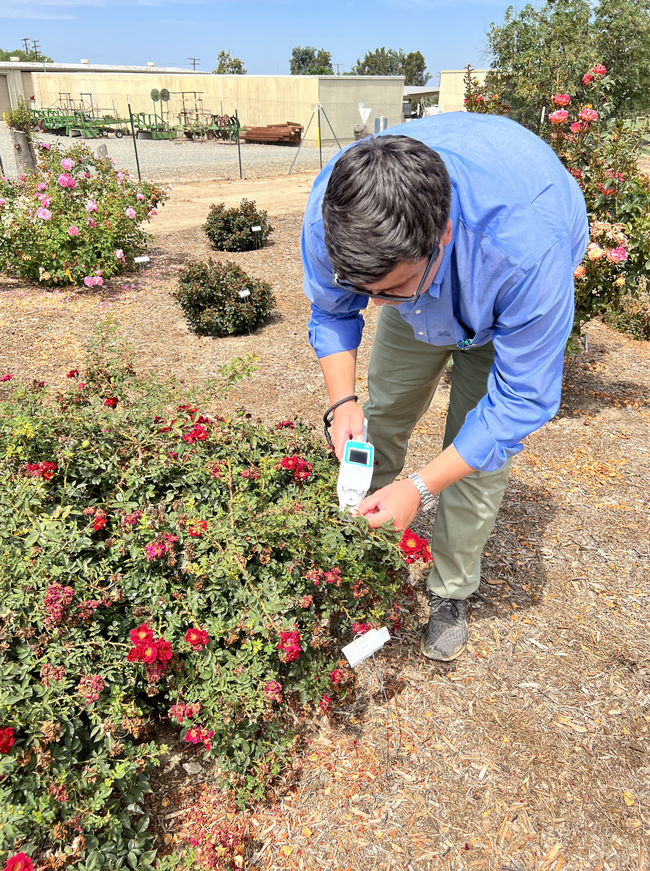Posts Tagged: Alison Van Eenennaam
Lawn-pocalypse! Surviving Drought
Ah, summer! The season of sunburns, pool parties, and… lawn droughts. If your once lush, green carpet now looks like a crunchy brown doormat, you're not alone. Let's dive into why your yard is staging a dramatic death scene and what you can do to...

Bermuda grass and weeds overtaking drought stressed turf grass.
Cattleman’s four decades of UCCE collaborations advance ranching practices
Siskiyou County rancher Jack Cowley has collaborated with UC Cooperative Extension scientists on research projects ranging from weed control to cow genetics for 40 years. The cooperation of farmers and ranchers is critical for producing practical research, scientists say. Photo by Alison Van Eenennaam
Eye doctor-turned-rancher brings science background to his second career
Siskiyou County rancher Jack Cowley, 91, joyfully recalled the special Christmas gift that delighted his seven children in the 1960s. Cowley, then a practicing eye doctor in Sacramento, and his late wife Barbara surprised the children with a white quarterhorse, which they named Silver.
“That's how it all started!” exclaimed Cowley, reflecting on the gift horse that would eventually lead to a 40-year collaboration with University of California Agriculture and Natural Resources.
Silver was the impetus for his family's involvement with the 4-H Youth Development Program, a part of UC ANR. Cowley also would later transition to a second career in cattle ranching, and collaborate with UC Cooperative Extension on research projects ranging from weed control to cow genetics.
“Jack has been an extremely committed supporter of UCCE,” said Grace Woodmansee, who became the UCCE livestock and natural resources advisor for Siskiyou County in 2021. “He has worked with UCCE extensively and contributed a lot of time and resources to supporting local and statewide projects.”
Lately Cowley and his son David have been working with Woodmansee and Gabriele Maier, UC Cooperative Extension specialist in the UC Davis School of Veterinary Medicine, on a cow deworming study.
Not only has Cowley allowed UCCE scientists to study his cattle over the years, he has been willing to personally share information with scientists and cattle producers across the country and internationally.
“It is important to foster exchange and linkages, said Dan Drake, UCCE farm advisor emeritus in Siskiyou County, who collaborated with Cowley for 30 years. “He went to so many meetings, especially with the early and uncharted areas of cattle genetics. Jack was on a first-name basis with the leaders from other states and the relationships were important in both directions. Frankly, I think many of those folks were jealous of the great cooperator we had in California.”
Breeding for better beef
After retiring from his Sacramento ophthalmology practice in the 1990s, Cowley settled in Montague in Siskiyou County, 246 miles north of the closest UC campus. There he met then-UC Cooperative Extension farm advisor Steve Orloff and Drake. Orloff advised him on alfalfa production and pasture management while Drake offered counsel on animal health records, organizing breeding, animal nutrition and water issues.
Drake explained to ranchers that by selectively breeding cows based on genetics, they could improve the production and quality of beef so that it's healthier for humans.
“My medical background helped me understand animal genetics,” Cowley said. “We can modify the genetics to improve the quality of the beef to make it more heart-healthy.”
In 2009, Drake introduced Cowley to UC Cooperative Extension specialist Alison Van Eenennaam, who studies animal genetics at UC Davis.
“I was looking to set up a research trial where we would follow cattle from the ranch all the way through to the Harris Ranch processing plant in the Central Valley,” said Van Eenennaam, who worked with Cowley on a three-year project.
Using DNA samples from Cowley's cattle, they evaluated the data they received from processor Harris Ranch of the beef characteristics – such as tenderness -- to compare the different breeds.
“I really thought I knew what I was doing and my cattle graded terribly,” Cowley said.
Since beginning the genetics project, his beef quality steadily improved.
“We're now up to where all of our animals are graded anywhere from 20% to 40% Prime and the rest Choice,” said Cowley, adding that he stopped striving for higher grades because the buyer said there was a limited market for the more expensive meat.
Cowley takes pride in knowing breeding practices developed from the research he and UC Cooperative Extension conducted have been adopted globally by dairy producers and beef producers.
“The type of research we were doing there has eventually evolved to now we have these genomic tests that you can use that genetically predict the performance of animals,” Van Eenennaam said. “Nowadays people just take an ear tag and send it in and get their genetic prediction.”
Van Eenennaam credits Cowley for allowing research on his large herd. “Jack was very patient with things that take a long time. When researchers come onto your ranch, that could slow you down.”
She added, “Genetic improvement, of course, is a huge component of sustainability because the more efficient cattle are, the less feed they consume and the less time they take to finish, which ultimately lessens their environmental footprint.”
Growing up in Utah
Looking back, Cowley marvels that he has been fortunate to do what he wanted to do in life.
“I was interested in ranching when I was probably seven or eight years of age,” said Cowley, who delivered the local Deseret Newspaper on horseback as a boy. “I grew up in Utah, you know, a little town in Utah called Holladay. It was not a ranching community.”
After serving four years in the Air Force during the Korean War, he returned to Utah to find the cute girl he met in first grade had graduated from college and was still single. He married Barbara in 1956. When he was accepted at George Washington University medical school, they drove with their three-week-old baby from Utah to Washington, D.C. He got a job in the Senate office building as an elevator operator working from 5 to 11 p.m., which enabled him to study, meet influential people and finish medical school without debt.
“I actually got to meet Khrushchev,” he said, recalling his encounter with the Soviet leader..
After finishing his ophthalmology residency at UCLA, Cowley established his practice in Sacramento and later taught a few classes at UC Davis Medical School.
Becoming a cattleman
One Saturday afternoon, after Silver the horse joined the family, Cowley and his oldest daughter, Kathryn, were driving in Placerville and saw a ranch for sale. He bought the 90 acres. For two summers, Barbara and the children lived at the ranch and Cowley joined them on weekends.
“Of course, I had to have a few cows to play with,” he said with a chuckle. “Basically, I thought I could make some money off of 50 cows.”
As his herd grew, he moved it to Corning, 50 miles south of Redding, and finally to the site in Montague that could accommodate several hundred head of cattle. “That's when I really became interested in animal genetics,” Cowley said. “That was back when we had slide rules to do our calculations. It was pretty crude, but it was a start.”
In 1990, Cowley was honored as the California Beef Cattle Improvement Association's Seedstock Producer of the year and, in 2007, was named Siskiyou County's Cattleman of the Year. He has served as president of the Siskiyou County Cattlemen's Association, on the Cattlemen's Beef Board, as well as on committees for the National Cattlemen's Beef Association.
“Jack spent countless hours traveling to the Midwest and other beef research institutions to share knowledge, learn more and plan for needed information,” said Drake, emeritus UCCE livestock advisor. This made for better Extension work, better research and recognition of UC Cooperative Extension work nationwide.”
In 2011, when Van Eenennaam and Drake presented their research at an international genomics conference, he joined them in Australia to learn from other researchers. They also visited Australian producers to learn their practices.
“We really rely on cooperators like Jack to enable our research to have translation to farmers and ranchers,” Van Eenennaam said.
In recent years, Cowley has handed the ranch reins over to his children David, Brian, Brent and Kathryn, who live in Siskiyou County.
David, who retired from a nearly 40-year career as a software engineer, plans to continue working with UC Cooperative Extension advisors and specialists.
“Any time you have questions, you can call and they're more than happy to help you,” he said.
Climate-Change Resources
University of California UC ANR Green Blog (Climate Change and Other Topics) https://ucanr.edu/blogs/Green/index.cfm?tagname=climate%20change (full index)
Examples:
- Save Trees First: Tips to Keep Them Alive Under Drought https://ucanr.edu/b/~CdD
- Landscaping with Fire Exposure in Mind: https://ucanr.edu/b/~G4D
- Cities in California Inland Areas Must Make Street Tree Changes to adapt to Future Climate https://ucanr.edu/b/~oF7
Drought, Climate Change and California Water Management Ted Grantham, UC Cooperative Extension specialist (23 minutes) https://youtu.be/dlimj75Wn9Q
Climate Variability and Change: Trends and Impacts on CA Agriculture Tapan Pathak, UC Cooperative Extension specialist (24 minutes) https://youtu.be/bIHI0yqqQJc
California Institute for Water Resources (links to blogs, talks, podcasts, water experts, etc.) https://ciwr.ucanr.edu/California_Drought_Expertise/
UC ANR Wildfire Resources (publications, videos, etc.) https://ucanr.edu/News/For_the_media/Press_kits/Wildfire/ (main website)
-UC ANR Fire Resources and Information https://ucanr.edu/sites/fire/ (main website)
-Preparing Home Landscaping https://ucanr.edu/sites/fire/Prepare/Landscaping/
UC ANR Free Publications https://anrcatalog.ucanr.edu/ (main website)
- Benefits of Plants to Humans and Urban Ecosystems: https://anrcatalog.ucanr.edu/pdf/8726.pdf
-Keeping Plants Alive Under Drought and Water Restrictions (English version) https://anrcatalog.ucanr.edu/pdf/8553.pdf
(Spanish version) https://anrcatalog.ucanr.edu/pdf/8628.pdf
- Use of Graywater in Urban Landscapes https://anrcatalog.ucanr.edu/pdf/8536.pdf
- Sustainable Landscaping in California https://anrcatalog.ucanr.edu/pdf/8504.pdf
Other (Non-UC) Climate Change Resources
Urban Forests and Climate Change. Urban forests play an important role in climate change mitigation and adaptation. Active stewardship of a community's forestry assets can strengthen local resilience to climate change while creating more sustainable and desirable places to live. https://www.fs.usda.gov/ccrc/topics/urban-forests
Examining the Viability of Planting Trees to Mitigate Climate Change (plausible at the forest level) https://climate.nasa.gov/news/2927/examining-the-viability-of-planting-trees-to-help-mitigate-climate-change/
Reports and other information resources coordinated under the auspices of the United Nations and produced through the collaboration of thousands of international scientists to provide a clear and up to date view of the current state of scientific knowledge relevant to climate change. United Nations Climate Action
Scientific reports, programs, action movements and events related to climate change. National Center for Atmospheric Research (National Science Foundation)
Find useful reports, program information and other documents resulting from federally funded research and development into the behavior of the atmosphere and related physical, biological and social systems. Search and find climate data from prehistory through to an hour ago in the world's largest climate data archive. (Formerly the "Climatic Data Center") National Centers for Environmental Information (NOAA)
Think tank providing information, analysis, policy and solution development for addressing climate change and energy issues (formerly known as the: "Pew Center on Global Climate Change"). Center for Climate & Energy Solutions (C2ES)
Mapping Resilience: A Blueprint for Thriving in the Face of Climate Disaster. The Climate Adaptation Knowledge Exchange (CAKE) was launched in July 2010 and is managed by EcoAdapt, a non-profit with a singular mission: to create a robust future in the face of climate change by bringing together diverse players to reshape planning and management in response to rapid climate change. https://www.cakex.org/documents/mapping-resilience-blueprint-thriving-face-climate-disaster
Cal-Adapt provides a way to explore peer-reviewed data that portrays how climate change might affect California at the state and local level. We make this data available through downloads, visualizations, and the Cal-Adapt API for your research, outreach, and adaptation planning needs. Cal-Adapt is a collaboration between state agency funding programs, university and private sector researchers https://cal-adapt.org/
Find reports, maps, data and other resources produced through a confederation of the research arms of 13 Federal departments and agencies that carry out research and develop and maintain capabilities that support the Nation's response to global change. Global Change (U.S. Global Change Research Program)
The Pacific Institute is a global water think tank that combines science-based thought leadership with active outreach to influence local, national, and international efforts to develop sustainable water policies. https://pacinst.org/our-approach/
Making equity real in climate adaptation and community resilience policies and programs: a guidebook. https://greenlining.org/publications/2019/making-equity-real-in-climate-adaption-and-community-resilience-policies-and-programs-a-guidebook/
Quarterly CA Climate Updates and CA Drought Monitor Maps (updated each Thursday) https://www.drought.gov/documents/quarterly-climate-impacts-and-outlook-western-region-june-2022
Drought focus of Water Resources IMPACT magazine special issue
UC ANR experts address emotional toll of drought
Preparing the American West for prolonged drought is the focus of a double issue of Water Resources IMPACT magazine. The California Water Commission staff are guest editors for this special open-access edition of the magazine, which is published by the American Water Resources Association.
Faith Kearns, academic coordinator of University of California Agriculture and Natural Resources' California Institute for Water Resources, is among the authors delving into how drought impacts people and the environment and how we can better prepare for the inevitable.
The first issue, published on Feb. 14, focuses on water scarcity issues confronting California and the ways these issues affect different sectors.
In “Trauma, Care, and Solidarity: Addressing the Emotional Toll of Chronic Drought,” Kearns highlights the effects of drought on mental health. She points to the spike in suicide hotline calls when wells ran dry in Southeast Asian communities in California's Central Valley.
By listening to Southeast Asian farmers, Ruth Dahlquist-Willard and Michael Yang of UC Cooperative Extension were able to “lighten the load” for them by providing pragmatic support, Kearns writes.
“The scale of some of these highly emotional issues – drought, wildfires, climate change – can make them seem incredibly difficult, if not impossible, to deal with,” Kearns said. “At the same time, they are affecting everyone living in the western U.S. on a daily basis. I wanted to highlight and provide models based on work that people – whether they are researchers, clinical psychologists, or Cooperative Extension advisors – are doing right now to ease the way.”
The authors who contributed to the double issue are a diverse array of Tribal experts, academics, nongovernmental organization thought-leaders, water managers and water policy influencers, each of whom brings their own perspective on the topic of drought. Their expertise and perspectives in climate science, water policy and water management will help inform drought-related decision-making and support policies that better prepare the state to thrive during periods of prolonged water scarcity.
In addition to Kearns, the first issue includes articles contributed by:
- Samantha Stevenson, University of California, Santa Barbara
- Jay Lund, University of California, Davis
- Ron Goode, North Fork Mono Tribe
- Andy Fecko, Placer County Water Agency
- Jeff Mount, Public Policy Institute of California, and Ted Grantham, University of California, Berkeley/UC Cooperative Extension
- Nat Seavy and Karyn Stockdale, National Audubon Society
- Kjia Rivers, Community Water Center
- Cannon Michael, Bowles Farming
- Michelle Reimers, Turlock Irrigation District
The January/February edition of Water Resources IMPACT magazine can be accessed, free of charge, on the American Water Resources Association website at https://www.awra.org under “Publications.”
The second issue, to be published in March, will focus on drought response, considering the options for adaptation. This two-part series complements the Commission's work on strategies to protect communities and fish and wildlife in the event of a long-term drought.
Your water-efficient landscape doesn’t have to be barren
UC climate-ready landscape trials identify low-water yet attractive plants
Good news: roses can be a part of your water-efficient landscape. Lorence Oki, UC Cooperative Extension environmental horticulture specialist in the UC Davis Department of Plant Sciences, identified rose cultivars that remain aesthetically pleasing with little water.
Oki is the principal investigator of the Climate-Ready Landscape Plants project, which may be the largest irrigation trial in the western U.S., and the UC Plant Landscape Irrigation Trials (UCLPIT), the California component of that project. These projects evaluate landscape plants under varying irrigation levels to determine their optimal performance in regions requiring supplemental summer water.
“There are some assumptions that pretty plants use a lot of water, like roses,” Oki said. “Everyone thinks they need a lot of water, but we've found some that don't, and they still look great. A water-efficient landscape doesn't need to look like a Central Valley oak-grassland in the summer. It can look really attractive.”
In 2021, Oki's team at UC Davis identified Lomandra confertifolia ssp. pallida "Pom Pom" Shorty and Rosa "Sprogreatpink" Brick House® Pink as two of the best low-water plants in the trial.
“The useful tip or information that is shared at the end of each trial is the selection and designation of plants as Blue Ribbon winners. These are the plants that looked good with an overall rating of 4 or higher throughout and were on the low (20%) water treatment,” said Natalie Levy, associate specialist for water resources, who manages the project at the UC ANR South Coast Research and Extension Center.
How plants earn a blue ribbon
Each trial year, the selection of new plants is based on research recommendations and donated submissions from the nursery industry. The landscape plants are trialed in full sun or 50% shade cover.
Irrigation treatments are based on the rate of evaporation and plant transpiration (evapotranspiration) measured through a local California Irrigation Management Information System (CIMIS) weather station that provides a reference evapotranspiration (ETo) rate.
Three levels of irrigation are provided to the plants equal to 20%, 50%, and 80% of ETo. The volume of water applied is the same at each irrigation based on soil characteristics, but the interval between applications varies with weather and the treatment. Using this method, irrigations for the 20% treatment are less frequent than the 80% treatment.
“The 20% treatment during the 2022 trial was irrigated an average of once per month while the 80% treatment was irrigated weekly,” explained Levy.
During the deficit irrigation trial, monthly height and width measurements are taken to determine the plant growth index. Monthly qualitative aesthetic ratings on a scale of 1 to 5 are determined for foliage appearance, flowering abundance, pest tolerance, disease resistance, vigor and overall appearance.
A second round of flowering abundance and overall appearance measurements are also taken to capture more of the blooming period. For example, UCLPIT identified in the 2020 trial at South Coast REC that the "Apricot Drift" rose had a mean overall appearance score of 3.5 out of 5, deeming it “acceptable to very nice” and a low water use plant within the Water Use Classification of Landscape Species or WUCOLS guide.
Project expands options for landscape planting
“(WUCOLS) only has 3,500 plants in it. There are guesses that there are close to 10,000 cultivars in urban landscapes in California, if not more,” said Oki. “WUCOLS also didn't have numerical ratings. Instead, you'll see verbal ratings like ‘low water use' or ‘high water use.'”
The UCLPIT project has not only developed numerical recommendations for irrigation, but it has also added new landscape plants that are compliant with California's Model Water Efficient Landscape Ordinance. In fact, UCLPIT's data is one of the few sources that can be used to supplement WUCOLS.
Geographic diversity of trial sites adds to knowledge base
In addition to UC Davis and South Coast REC in Irvine, the trials have expanded beyond California as the Climate-Ready Landscape Plants project and is in progress at Oregon State University, University of Washington, University of Arizona and Utah State University thanks to a USDA/CDFA grant awarded in 2020.
Lloyd Nackley, associate professor of nursery production and greenhouse management at Oregon State University, is the principal investigator of the trial in the Portland metro area, which is entering its third year.
“People know that there are drought tolerant plants, but there are many. We're trying to highlight lesser known or newer varieties. And even though the trial is three years, most gardeners would hope that their garden lasts longer than that,” said Nackley.
One of the observations that Nackley recalls is of the Hibiscus Purple Pillar plant. Unlike the trial at South Coast, the Purple Pillar did not perform well in Oregon in the spring.
“It wasn't until August that we saw the plant bloom and begin to look like what we saw from South Coast in April,” Nackley said.
Ursula Schuch, horticulture professor and principal investigator of the trial taking place at the University of Arizona, was also surprised at the range of performance among different plant types and the effects of irrigation, heat and temperature.
“This research will reassure green industry professionals that they can stretch their water budget to successfully cultivate more plants, watering them according to their needs instead of irrigating every plant according to the highest water-using plants,” said Schuch.
Although research is only conducted in the West, the hope is that there will be trials in other regions of U.S.
Doing so would yield comprehensive information about the plants and their performance in different climates. As extreme weather events persist in the U.S., disease pressure and risks do too. Trials throughout the country would provide location-specific data regarding disease susceptibility.
To learn more about the UCLPIT research project, visit https://ucanr.edu/sites/UCLPIT/

